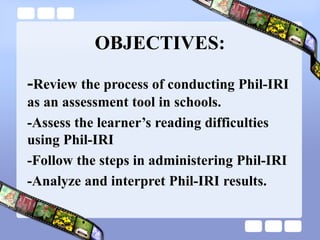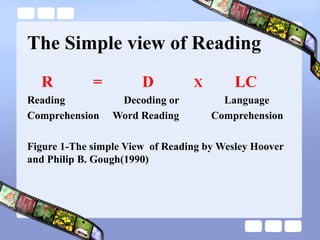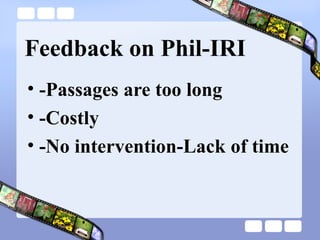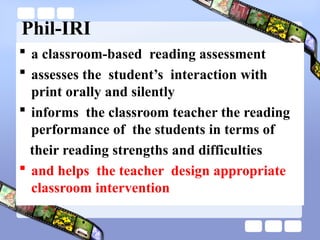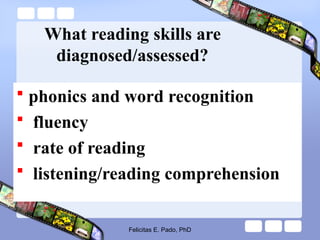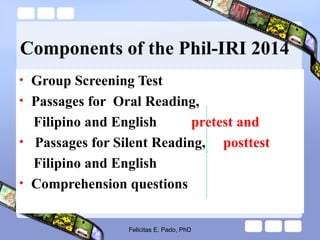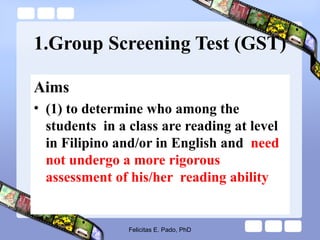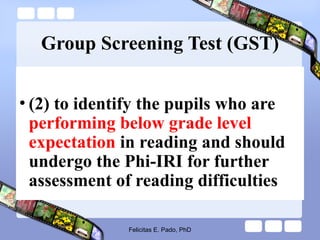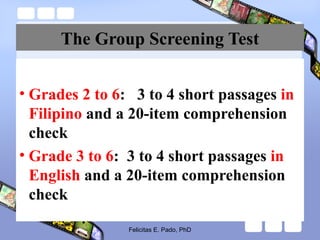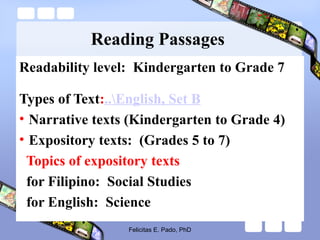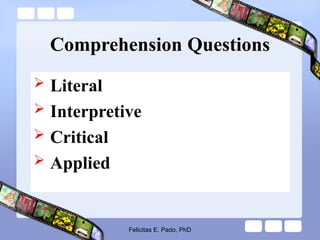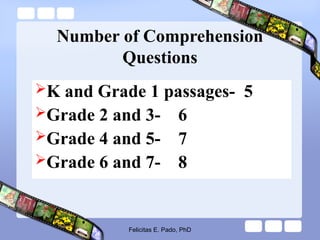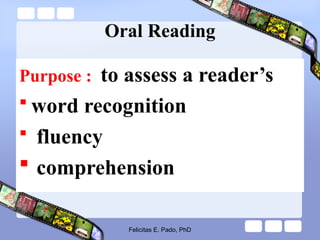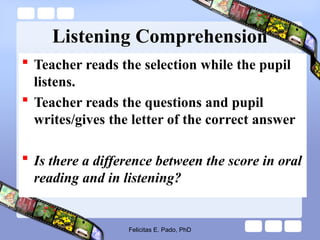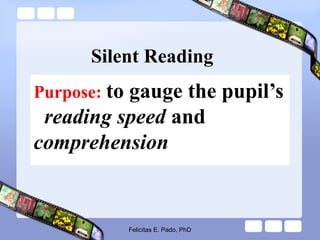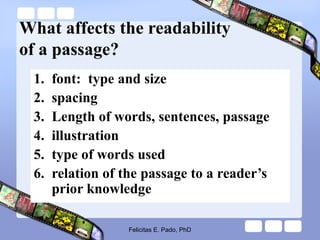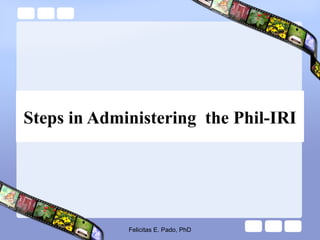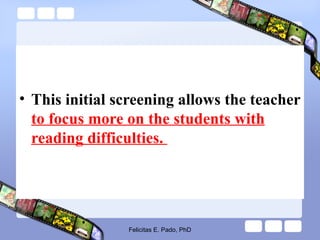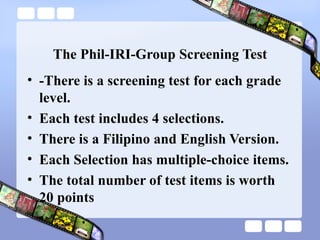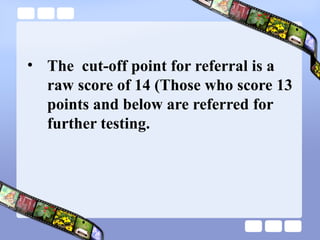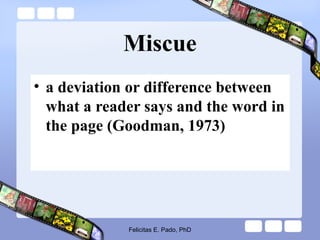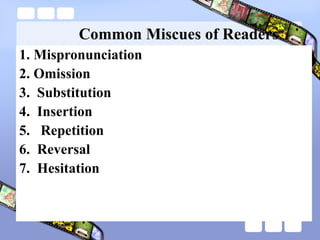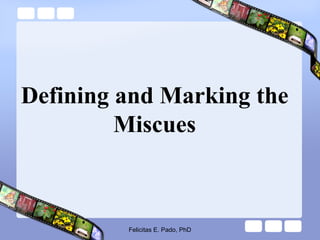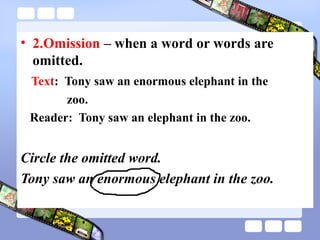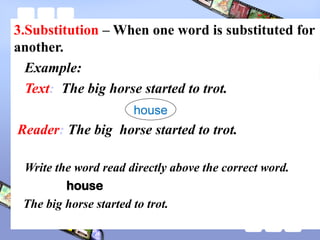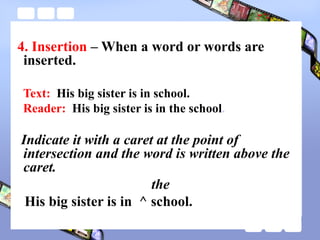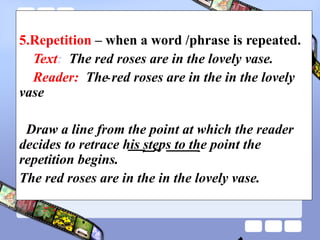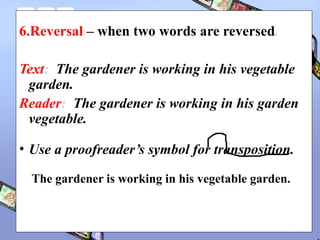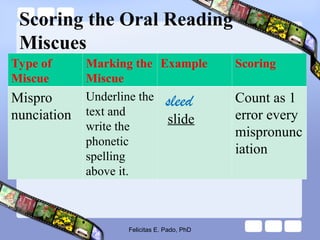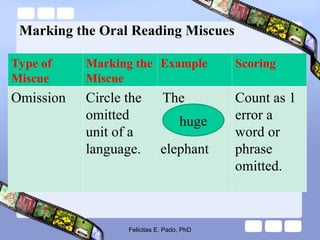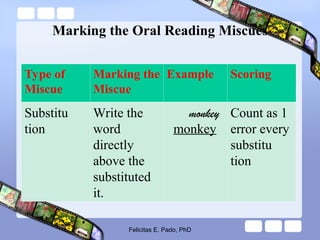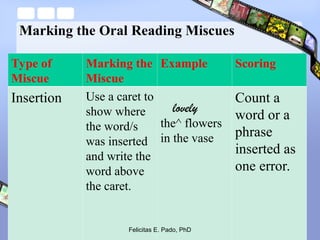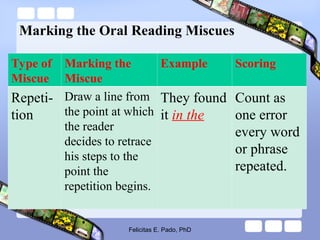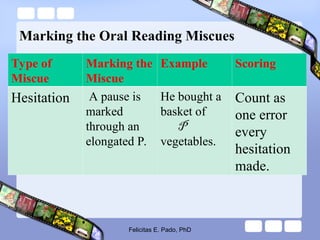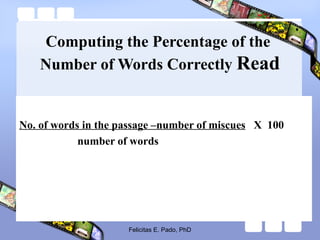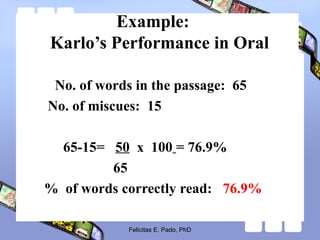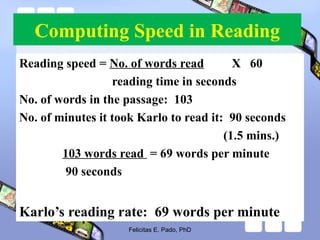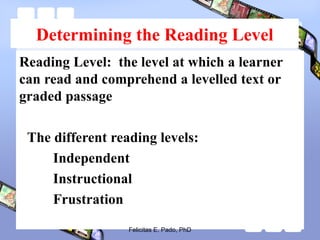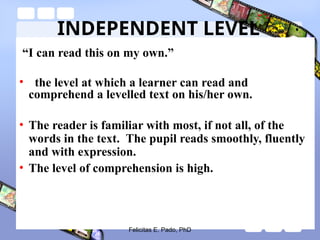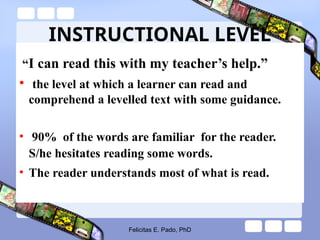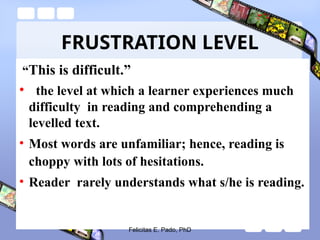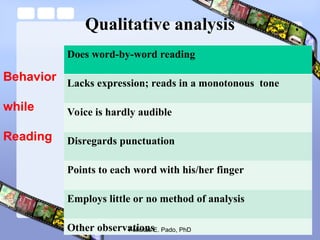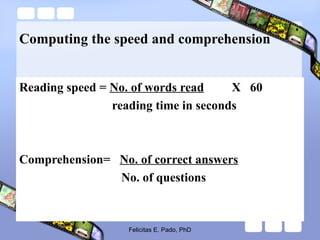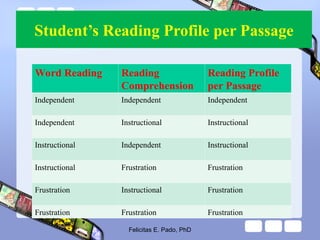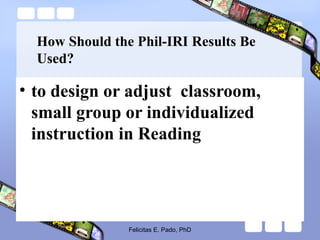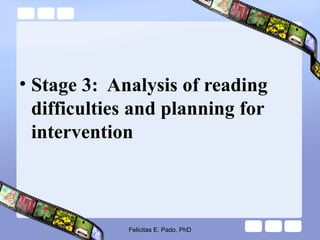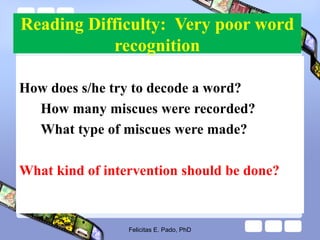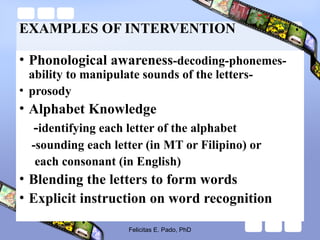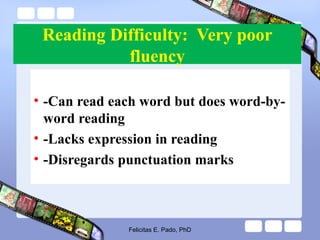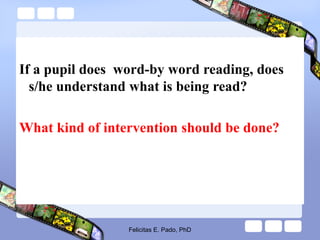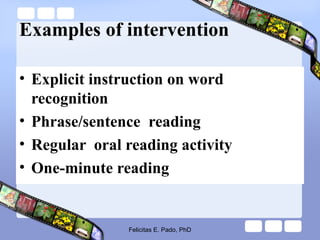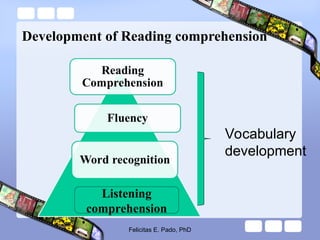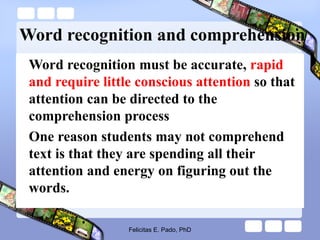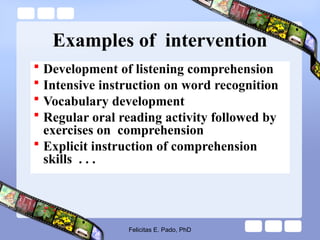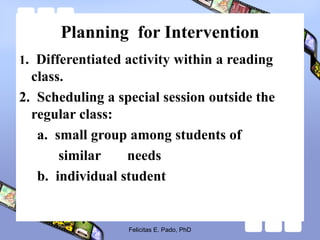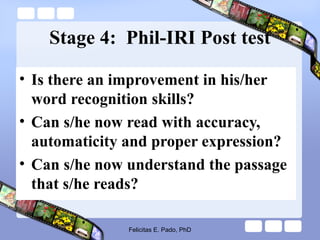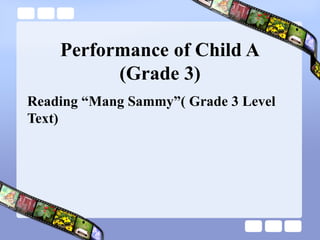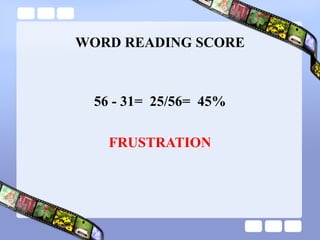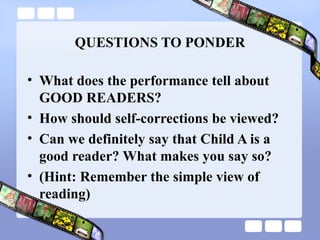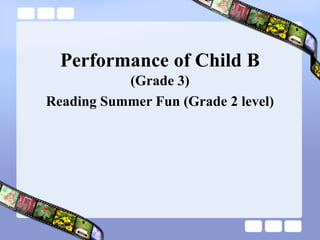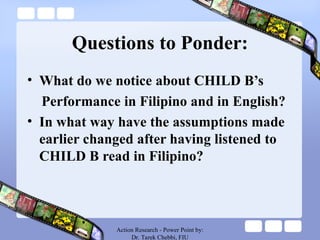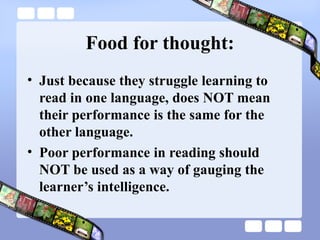INSET 2024 phil-iri-slide-.pptpppppppppp
- 1. READING ASSESSMENT THE Phil-IRI: Assessing the LEARNERSŌĆÖ READING DIFFICULTIES and DESIGNING Appropriate Intervention Felicitas E. Pado, PhD Presented by: MARRY LEE A. AJERO Master Teacher I
- 2. OBJECTIVES: -Review the process of conducting Phil-IRI as an assessment tool in schools. -Assess the learnerŌĆÖs reading difficulties using Phil-IRI -Follow the steps in administering Phil-IRI -Analyze and interpret Phil-IRI results.
- 3. In What level will you belong based on the statements? Level 1- I have heard of Phil-IRI. Level 2-I know about Phil-IRI, but I have never used it. Level 3- I know about Phil-IRI,I use it in my class as an assessment tool. Level 4- I know about Phil-IRI,I use it in my class as an assessment tool for classroom intervention.
- 4. Give at least one adjective that will describe Phil-IRIŌĆÖs: a. Strengths b. Weaknesses c. Challenges
- 5. The Simple view of Reading R = D X LC Reading Decoding or Language Comprehension Word Reading Comprehension Figure 1-The simple View of Reading by Wesley Hoover and Philip B. Gough(1990)
- 6. Feedback on Phil-IRI ŌĆó -Passages are too long ŌĆó -Costly ŌĆó -No intervention-Lack of time
- 7. ’ƬWHAT IS Phil-IRI? ’ƬThe Phil-IRI is one of the initiatives put in place in support of the Every Child A Reader Program of the Department of Education
- 8. Phil-IRI ’é¦ a classroom-based reading assessment ’é¦ assesses the studentŌĆÖs interaction with print orally and silently ’é¦ informs the classroom teacher the reading performance of the students in terms of their reading strengths and difficulties ’é¦ and helps the teacher design appropriate classroom intervention
- 9. What reading skills are diagnosed/assessed? ’é¦ phonics and word recognition ’é¦ fluency ’é¦ rate of reading ’é¦ listening/reading comprehension Felicitas E. Pado, PhD
- 10. Components of the Phil-IRI 2014 ŌĆó Group Screening Test ŌĆó Passages for Oral Reading, Filipino and English pretest and ŌĆó Passages for Silent Reading, posttest Filipino and English ŌĆó Comprehension questions Felicitas E. Pado, PhD
- 11. 1.Group Screening Test (GST) Aims ŌĆó (1) to determine who among the students in a class are reading at level in Filipino and/or in English and need not undergo a more rigorous assessment of his/her reading ability Felicitas E. Pado, PhD
- 12. Group Screening Test (GST) ŌĆó (2) to identify the pupils who are performing below grade level expectation in reading and should undergo the Phi-IRI for further assessment of reading difficulties Felicitas E. Pado, PhD
- 13. The Group Screening Test ŌĆó Grades 2 to 6: 3 to 4 short passages in Filipino and a 20-item comprehension check ŌĆó Grade 3 to 6: 3 to 4 short passages in English and a 20-item comprehension check Felicitas E. Pado, PhD
- 14. The Phil-IRI Tests Felicitas E. Pado, PhD
- 15. Reading Passages Readability level: Kindergarten to Grade 7 Types of Text:..English, Set B ŌĆó Narrative texts (Kindergarten to Grade 4) ŌĆó Expository texts: (Grades 5 to 7) Topics of expository texts for Filipino: Social Studies for English: Science Felicitas E. Pado, PhD
- 16. Comprehension Questions ’āś Literal ’āś Interpretive ’āś Critical ’āś Applied Felicitas E. Pado, PhD
- 17. Number of Comprehension Questions ’āśK and Grade 1 passages- 5 ’āśGrade 2 and 3- 6 ’āśGrade 4 and 5- 7 ’āśGrade 6 and 7- 8 Felicitas E. Pado, PhD
- 18. Oral Reading Purpose : to assess a readerŌĆÖs ’é¦ word recognition ’é¦ fluency ’é¦ comprehension Felicitas E. Pado, PhD
- 19. Assessing Oral Reading Performance ŌĆó Word Recognition: measured through a Reading Miscue Inventory ŌĆó Rate of Reading: measured by recording the time spent in reading the selection. ŌĆó Comprehension: measured by answering 5 to 8ŌĆōitem comprehension questions Felicitas E. Pado, PhD
- 20. Listening Comprehension Is the difficulty in answering the comprehension questions due to poor word recognition skills? Felicitas E. Pado, PhD
- 21. ŌĆó Listening Comprehension assesses how well the pupil understands the passage that she/he listened to. Felicitas E. Pado, PhD
- 22. Listening Comprehension ’é¦ Teacher reads the selection while the pupil listens. ’é¦ Teacher reads the questions and pupil writes/gives the letter of the correct answer ’é¦ Is there a difference between the score in oral reading and in listening? Felicitas E. Pado, PhD
- 23. Silent Reading Purpose: to gauge the pupilŌĆÖs reading speed and comprehension Felicitas E. Pado, PhD
- 24. Silent Reading ŌĆó Reading speed: measured by recording the time it takes the child to read each passage completely ŌĆó Reading comprehension: measured by asking the student to read and answer 5 to 8 comprehension questions Felicitas E. Pado, PhD
- 25. What affects the readability of a passage? 1. font: type and size 2. spacing 3. Length of words, sentences, passage 4. illustration 5. type of words used 6. relation of the passage to a readerŌĆÖs prior knowledge Felicitas E. Pado, PhD
- 26. Recommended Font Size of the Passages Grade Level Recommended Font Size Kindergarten ŌĆōGrade 1 Comic Sans,/Century Gothic Font Size 18 Grade 2 Comic Sans/Century Gothic , Font Size 16 Grade 3 Comic Sans,/Century Gothic Font Size 14 Grade 4 Comic Sans/Century Gothic, Font Size 12 Felicitas E. Pado, PhD
- 27. Steps in Administering the Phil-IRI Felicitas E. Pado, PhD
- 28. Stage 1: ŌĆó Administration of the Initial Screening : Group Screening Test Felicitas E. Pado, PhD
- 29. Interpreting the Results of GST Raw score 0-7 points take the Phil-IRI test which is 3 levels lower than his/her grade level in GST 8-13 points take the Phil-IRI test which is 2 levels lower than his/her grade level 14 or above NO need to undergo the Phil-IRI test Felicitas E. Pado, PhD
- 30. ŌĆó This initial screening allows the teacher to focus more on the students with reading difficulties. Felicitas E. Pado, PhD
- 31. The Phil-IRI-Group Screening Test ŌĆó -There is a screening test for each grade level. ŌĆó Each test includes 4 selections. ŌĆó There is a Filipino and English Version. ŌĆó Each Selection has multiple-choice items. ŌĆó The total number of test items is worth 20 points
- 32. ŌĆó The cut-off point for referral is a raw score of 14 (Those who score 13 points and below are referred for further testing.
- 33. ŌĆó Stage 2. Administration of the Phil-IRI A. Oral Reading Test Objectives: ’é¦ identify the studentŌĆÖs miscues in oral reading; ŌĆó record the number of words that a student reads per minute; and ’é¦ find out how well a student understands the passage read Felicitas E. Pado, PhD
- 34. Miscue ŌĆó a deviation or difference between what a reader says and the word in the page (Goodman, 1973) Felicitas E. Pado, PhD
- 35. Common Miscues of Readers 1. Mispronunciation 2. Omission 3. Substitution 4. Insertion 5. Repetition 6. Reversal 7. Hesitation
- 36. Defining and Marking the Miscues Felicitas E. Pado, PhD
- 37. 1.Mispronunciation ŌĆō when a word or words is not pronounced or read properly (pupil reads a word phonetically) Text: The children played in the yard. Reader: playeed The children played in the yard. Underline the text and write the phonetic spelling above it. Felicitas E. Pado, PhD
- 38. ŌĆó 2.Omission ŌĆō when a word or words are omitted. Text: Tony saw an enormous elephant in the zoo. Reader: Tony saw an elephant in the zoo. Circle the omitted word. Tony saw an enormous elephant in the zoo.
- 39. 3.Substitution ŌĆō When one word is substituted for another. Example: Text: The big horse started to trot. Reader: The big horse started to trot. Write the word read directly above the correct word. house The big horse started to trot. house
- 40. 4. Insertion ŌĆō When a word or words are inserted. Text: His big sister is in school. Reader: His big sister is in the school. Indicate it with a caret at the point of intersection and the word is written above the caret. the His big sister is in ^ school.
- 41. 5.Repetition ŌĆō when a word /phrase is repeated. Text: The red roses are in the lovely vase. Reader: The red roses are in the in the lovely vase Draw a line from the point at which the reader decides to retrace his steps to the point the repetition begins. The red roses are in the in the lovely vase.
- 42. 6.Reversal ŌĆō when two words are reversed. Text: The gardener is working in his vegetable garden. Reader: The gardener is working in his garden vegetable. ŌĆó Use a proofreaderŌĆÖs symbol for transposition. The gardener is working in his vegetable garden.
- 43. Scoring the Oral Reading Miscues Type of Miscue Marking the Miscue Example Scoring Mispro nunciation Underline the text and write the phonetic spelling above it. sleed slide Count as 1 error every mispronunc iation Felicitas E. Pado, PhD
- 44. Marking the Oral Reading Miscues Type of Miscue Marking the Miscue Example Scoring Omission Circle the omitted unit of a language. The elephant Count as 1 error a word or phrase omitted. Felicitas E. Pado, PhD huge
- 45. Marking the Oral Reading Miscues Type of Miscue Marking the Miscue Example Scoring Substitu tion Write the word directly above the substituted it. monkey monkey Count as 1 error every substitu tion Felicitas E. Pado, PhD
- 46. Marking the Oral Reading Miscues Type of Miscue Marking the Miscue Example Scoring Insertion Use a caret to show where the word/s was inserted and write the word above the caret. lovely the^ flowers in the vase Count a word or a phrase inserted as one error. Felicitas E. Pado, PhD
- 47. Marking the Oral Reading Miscues Type of Miscue Marking the Miscue Example Scoring Repeti- tion Draw a line from the point at which the reader decides to retrace his steps to the point the repetition begins. They found it in the Count as one error every word or phrase repeated. Felicitas E. Pado, PhD
- 48. Marking the Oral Reading Miscues Type of Miscue Marking the Miscue Example Scoring Reversal Write the word/nonw ord above the correct word. dab bad Count as one error every reversal made. Felicitas E. Pado, PhD
- 49. Marking the Oral Reading Miscues Type of Miscue Marking the Miscue Example Scoring Hesitation A pause is marked through an elongated P. He bought a basket of P vegetables. Count as one error every hesitation made. Felicitas E. Pado, PhD
- 50. Quantitative Analysis of the Oral Reading Test ŌĆó How many miscues were observed? What are these miscues? How many minutes did it take the student to read the passage? How many comprehension questions were correctly answered? Felicitas E. Pado, PhD
- 51. Computing the Percentage of the Number of Words Correctly Read No. of words in the passage ŌĆōnumber of miscues X 100 number of words Felicitas E. Pado, PhD
- 52. Example: KarloŌĆÖs Performance in Oral Reading No. of words in the passage: 65 No. of miscues: 15 65-15= 50 x 100 = 76.9% 65 % of words correctly read: 76.9% Felicitas E. Pado, PhD
- 53. Computing Speed in Reading Reading speed = No. of words read X 60 reading time in seconds No. of words in the passage: 103 No. of minutes it took Karlo to read it: 90 seconds (1.5 mins.) 103 words read = 69 words per minute 90 seconds KarloŌĆÖs reading rate: 69 words per minute Felicitas E. Pado, PhD
- 54. Computing for Comprehension Comprehension= No. of correct answers No. of questions No. of correct answers: 4 Total no. of questions: 7 4/7 = 57 KarloŌĆÖs comprehension skill: 57% Felicitas E. Pado, PhD
- 55. Determining the Reading Level Reading Level: the level at which a learner can read and comprehend a levelled text or graded passage ’éŚThe different reading levels: ’āśIndependent ’āśInstructional ’āśFrustration Felicitas E. Pado, PhD
- 56. INDEPENDENT LEVEL ŌĆ£I can read this on my own.ŌĆØ ŌĆó the level at which a learner can read and comprehend a levelled text on his/her own. ŌĆó The reader is familiar with most, if not all, of the words in the text. The pupil reads smoothly, fluently and with expression. ŌĆó The level of comprehension is high. Felicitas E. Pado, PhD
- 57. INSTRUCTIONAL LEVEL ŌĆ£I can read this with my teacherŌĆÖs help.ŌĆØ ŌĆó the level at which a learner can read and comprehend a levelled text with some guidance. ŌĆó 90% of the words are familiar for the reader. S/he hesitates reading some words. ŌĆó The reader understands most of what is read. Felicitas E. Pado, PhD
- 58. FRUSTRATION LEVEL ŌĆ£This is difficult.ŌĆØ ŌĆó the level at which a learner experiences much difficulty in reading and comprehending a levelled text. ŌĆó Most words are unfamiliar; hence, reading is choppy with lots of hesitations. ŌĆó Reader rarely understands what s/he is reading. Felicitas E. Pado, PhD
- 59. Oral Reading Profile Word Reading Score (in %) Comprehension Score (in %) Oral Reading Level 97-100% 80-100% Independent 90-96% 59-79% Instructional 89% and below 58% and below Frustration Felicitas E. Pado, PhD
- 60. KarloŌĆÖs Reading Profile ŌĆó Word reading score: 15 miscues= 76.9%: Frustration ŌĆó Comprehension score: 4 out of 7= 57%: Frustration KarloŌĆÖs Oral Reading Profile: Frustration Felicitas E. Pado, PhD
- 61. ŌĆó What should the teacher do with pupils like Karlo? Felicitas E. Pado, PhD
- 62. Qualitative analysis Does word-by-word reading Lacks expression; reads in a monotonous tone Voice is hardly audible Disregards punctuation Points to each word with his/her finger Employs little or no method of analysis Other observations Felicitas E. Pado, PhD Behavior while Reading
- 63. B. Listening Comprehension ŌĆó What is the level of comprehension? Felicitas E. Pado, PhD
- 64. C. The Phil-IRI Silent Reading Test Assesses the studentŌĆÖs ŌĆó reading speed ŌĆó comprehension Felicitas E. Pado, PhD
- 65. Computing the speed and comprehension Reading speed = No. of words read X 60 reading time in seconds Comprehension= No. of correct answers No. of questions Felicitas E. Pado, PhD
- 66. StudentŌĆÖs Reading Profile per Passage Word Reading Reading Comprehension Reading Profile per Passage Independent Independent Independent Independent Instructional Instructional Instructional Independent Instructional Instructional Frustration Frustration Frustration Instructional Frustration Frustration Frustration Frustration Felicitas E. Pado, PhD
- 67. How Should the Phil-IRI Results Be Used? ŌĆó to design or adjust classroom, small group or individualized instruction in Reading Felicitas E. Pado, PhD
- 68. ŌĆó Stage 3: Analysis of reading difficulties and planning for intervention Felicitas E. Pado, PhD
- 69. Reading Difficulty: Very poor word recognition How does s/he try to decode a word? How many miscues were recorded? What type of miscues were made? What kind of intervention should be done? Felicitas E. Pado, PhD
- 70. EXAMPLES OF INTERVENTION ŌĆó Phonological awareness-decoding-phonemes- ability to manipulate sounds of the letters- ŌĆó prosody ŌĆó Alphabet Knowledge -identifying each letter of the alphabet -sounding each letter (in MT or Filipino) or each consonant (in English) ŌĆó Blending the letters to form words ŌĆó Explicit instruction on word recognition Felicitas E. Pado, PhD
- 71. Reading Difficulty: Very poor fluency ŌĆó -Can read each word but does word-by- word reading ŌĆó -Lacks expression in reading ŌĆó -Disregards punctuation marks Felicitas E. Pado, PhD
- 72. If a pupil does word-by word reading, does s/he understand what is being read? What kind of intervention should be done? Felicitas E. Pado, PhD
- 73. Examples of intervention ŌĆó Explicit instruction on word recognition ŌĆó Phrase/sentence reading ŌĆó Regular oral reading activity ŌĆó One-minute reading Felicitas E. Pado, PhD
- 74. Reading Difficulty: Very poor comprehension ŌĆó Very poor word recognition (PWR) ŌĆó Word ŌĆōby-word reading (F) ŌĆó Does not understand most of the words (V) ŌĆó ŌĆ£Can read the whole passage but canŌĆÖt understand what is being read.ŌĆØ (C) Felicitas E. Pado, PhD
- 75. Development of Reading comprehension Felicitas E. Pado, PhD Vocabulary development Listening comprehension
- 76. Word recognition and comprehension ’éŚWord recognition must be accurate, rapid and require little conscious attention so that attention can be directed to the comprehension process ’éŚOne reason students may not comprehend text is that they are spending all their attention and energy on figuring out the words. Felicitas E. Pado, PhD
- 77. Examples of intervention ’é¦ Development of listening comprehension ’é¦ Intensive instruction on word recognition ’é¦ Vocabulary development ’é¦ Regular oral reading activity followed by exercises on comprehension ’é¦ Explicit instruction of comprehension skills . . . Felicitas E. Pado, PhD
- 78. Planning for Intervention 1. Differentiated activity within a reading class. 2. Scheduling a special session outside the regular class: a. small group among students of similar needs b. individual student Felicitas E. Pado, PhD
- 79. Stage 4: Phil-IRI Post test ŌĆó Is there an improvement in his/her word recognition skills? ŌĆó Can s/he now read with accuracy, automaticity and proper expression? ŌĆó Can s/he now understand the passage that s/he reads? Felicitas E. Pado, PhD
- 80. Analyze the post test results -Is there reading progress? -What reading difficulties were addressed?; what reading difficulties still persist? -What other interventions should be done? Felicitas E. Pado, PhD
- 81. LETŌĆÖS PRACTICE
- 82. Performance of Child A (Grade 3) Reading ŌĆ£Mang SammyŌĆØ( Grade 3 Level Text)
- 83. WORD READING SCORE 56 - 31= 25/56= 45% FRUSTRATION
- 84. QUESTIONS TO PONDER ŌĆó What does the performance tell about GOOD READERS? ŌĆó How should self-corrections be viewed? ŌĆó Can we definitely say that Child A is a good reader? What makes you say so? ŌĆó (Hint: Remember the simple view of reading)
- 85. FOOD FOR THOUGHT ŌĆó Even good readers make mistakes. ŌĆó Self-correction shows that some monitoring of oneŌĆÖs reading is occurring as a STRENGHT. ŌĆó Remember decoding by itself is NOT reading.
- 86. Word Reading Score 91- 9 = 82/91 = 90% INSTRUCTIONAL LEVEL Action Research - Power Point by: Dr. Tarek Chebbi, FIU
- 87. Performance of Child B (Grade 3) Reading Summer Fun (Grade 2 level)
- 88. Questions to Ponder: ŌĆó What do we notice about CHILD BŌĆÖs Performance in Filipino and in English? ŌĆó In what way have the assumptions made earlier changed after having listened to CHILD B read in Filipino? Action Research - Power Point by: Dr. Tarek Chebbi, FIU
- 89. Food for thought: ŌĆó Just because they struggle learning to read in one language, does NOT mean their performance is the same for the other language. ŌĆó Poor performance in reading should NOT be used as a way of gauging the learnerŌĆÖs intelligence.
- 90. SHARING TIME
- 91. THANK YOU FOR LISTENING! GOD BLESS ŌĆ”
Editor's Notes
- #18: WHEN USED TO ASSESS ORAL READING SKILLS,PHILIRI MAY BE USED TO DESCRIBE DECODING THE ABILITY TO READ ISOLATED WORD USING PHONICS LANGUAGE FLUENCY-READING WITH SPEED,ACCURACY AND PROSODY-THE PATTERNS OF STRESS AND INTONATION IN A LANGUAGE WORD RECOGNITION-THE ABILITY TO IDENTIFY AUTOMATICALLY WORDS ON SIGHT

